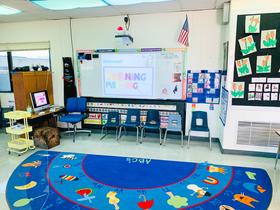For the 2025-26 school year, there are 2 public preschools serving 446 students in Stoughton, MA.
The top ranked public preschool in Stoughton, MA is Richard L. Wilkins Elementary School. Overall testing rank is based on a school's combined math and reading proficiency test score ranking.
Stoughton, MA public preschools have an average math proficiency score of 57% (versus the Massachusetts public pre school average of 36%), and reading proficiency score of 57% (versus the 37% statewide average). Pre schools in Stoughton have an average ranking of 9/10, which is in the top 20% of Massachusetts public pre schools.
Minority enrollment is 61% of the student body (majority Black and Hispanic), which is more than the Massachusetts public preschool average of 53% (majority Hispanic).
Best Public Preschools in Stoughton, MA (2025-26)
School
(Math and Reading Proficiency)
(Math and Reading Proficiency)
Location
Quick Facts
Rank: #11.
Richard L. Wilkins Elementary School
(Math: 55-59% | Reading: 55-59%)
Rank:
Rank:
8/
Top 30%10
1322 Central Street
Stoughton, MA 02072
(781) 344-7005
Stoughton, MA 02072
(781) 344-7005
Gr: PK-5 | 333 students Student-teacher ratio: 12:1 Minority enrollment: 58%
Rank: n/an/a
137 Walnut Street
Stoughton, MA 02072
(781) 344-1003
Stoughton, MA 02072
(781) 344-1003
Gr: PK | 113 students Student-teacher ratio: 11:1 Minority enrollment: 70%
Frequently Asked Questions
What are the top ranked public preschools in Stoughton, MA?
The top ranked public preschools in Stoughton, MA include Richard L. Wilkins Elementary School.
How many public preschools are located in Stoughton?
2 public preschools are located in Stoughton.
What is the racial composition of students in Stoughton?
Stoughton public preschools minority enrollment is 61% of the student body (majority Black and Hispanic), which is more than the Massachusetts public preschools average of 53% (majority Hispanic).
Recent Articles

Gifted & Talented Programs in Public Schools
Explore opportunities and controversies in gifted & talented programs—equity, outcomes, and models shaping public education in 2025.

Evaluating STEM in Public Schools: A Parent & District Guide
A guide to evaluating STEM programs in public school districts—metrics, best practices, equity, and 2025 trends for parents and community stakeholders.

Special Education in Public Schools: Understanding IEPs & Services
What parents need to know about IEPs, services, rights, and how to get the best support in public schools in 2025.
